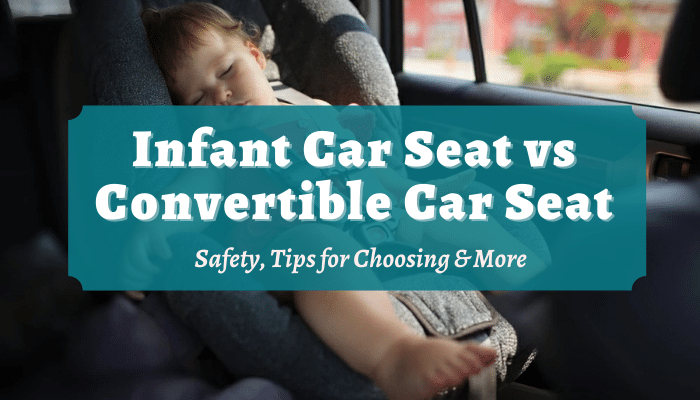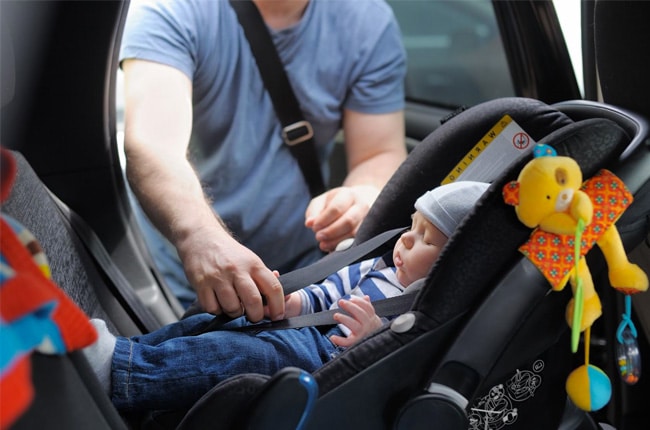
For new parents, having a baby can be an exciting and joyous, yet stressful experience. Before having the baby, parents will spend many days making sure that they have everything they need to keep their baby safe and comfortable. One of the most important of these essentials is deciding what car seat to use.
If you’re not sure what you’re looking for, buying a car seat can be an overwhelming task and can spark questions that you didn’t even know needed answering. For example, what’s an infant car seat? What’s a convertible car seat? What’s the difference between the two? How do I decide which car seat I need? I mean, aren’t they all technically the same?
This article will strive to provide detailed answers to these questions so that when you buy your first car seat, you can feel confident in that decision. At the end of the article, I’ll also answer frequently asked questions regarding if one type of car seat is safer than the other and how to tell when to transition your little one from one to the other.
Infant Car Seats
What is an Infant Car Seat?
An infant car seat is a rear-facing car seat that’s designed for infants and toddlers. Most of them typically have a maximum weight limit ranging from 22 to 35 pounds. Usually, infant car seats are the first type of car seat that parents will start with.
Infant car seats are comprised of two parts: the infant carrier and the base. The infant carrier can be easily removed from the base and installed into strollers and rockers so that you don’t have to carry the carrier around all of the time. Also, most infant car seats are designed to be universal devices, meaning that the infant carrier can be attached to bases other than its own. This makes it easier to transfer your car seat from car to car without going through the hassle of uninstalling your car seat.
How Safe Are Infant Car Seats?
If they’re being used correctly and have been installed properly, infant car seats can be very safe to use. I won’t go as far as to say that it’s safer to use than any other type of car seat, but they’re pretty safe when they’re used right.
According to the American Academy of Pediatrics, infant car seats should only ever be used in the rear-facing position. It’s also strongly recommended that you bring your child home from the hospital in an infant car seat. Once your child has reached or exceeds the height and weight requirements outlined by your car seat manufacturer, that will be the only time that they should transition to a forward-facing car seat.
Where infant car seats can become unsafe is when parents use the infant carrier for anything other than transporting their little one from one place to another. One of the most common mistakes that new parents make with infant car seats is leaving their child in the carrier for too long. Infant carriers should NOT be used for sleeping, feeding, or any other purpose outside of transportation.
In an article on Today, a mother recounted the tragic story of losing her 13-month old daughter who passed away due to falling asleep in her car seat. When a child falls asleep in their infant car seat, they’re falling asleep at a reclined angle, which can cause Positional Asphyxia - a situation where the baby’s airways are cut off due to their sleeping position.
As I said earlier, if they’re being used correctly, then infant car seats can be a great and safe way to get your baby from point A to point B.
Why Choose an Infant Car Seat?
While infant car seats come highly recommended due to their rear-facing only positioning, as I mentioned in the previous section, they’re extraordinary convenient. For one, infant car seats can easily detach from its base. So, unlike almost every other type of car seat, you don’t have to uninstall an infant car seat in order to move it. If you’ve ever had to uninstall a car seat, then you understand the hassle and frustration that comes with it. Infant car seats get rid of all of that negativity.
In addition to that, most infant car seats are designed to fit different types of bases. So, not only can they be removed easily, but they can also be installed in different vehicles. With infant car seats, it’s convenience on top of convenience, which is why most parents choose them as opposed to rear-facing convertibles (we’ll get into what those are in a bit).
What to Look for in an Infant Car Seat
When purchasing an infant car seat, there are several key factors that you’ll want to keep your eye out for. They include but are not limited to:
Convertible Car Seats
What is a Convertible Car Seat?
Unlike infant car seats, a convertible car seat can be used in both the rear-facing and forward-facing positions. Most convertible car seats have a maximum weight limit of 65 pounds or more, so they can be used from the time you leave the hospital until it’s time to transition your child to a forward-facing booster seat.
When going from the rear-facing to forward-fsacing position, it’s important that you abide by the height and weight requirements that are outlined in your car seat manual. Also, keep in mind that if your child meets the minimum height and weight requirements, it doesn’t necessarily mean that they’re ready to sit in the forward-facing position.
How safe are convertible car seats?
Like any other car seat, convertible car seats are very safe if they’re used and installed correctly. However, a common mistake that most parents make when using a convertible car seat is transitioning their baby from the rear-facing to the forward-facing position too early. Doing this can put your little one at risk of serious injury, so you should know, without a shadow of a doubt, when you should convert your car seat.
Generally, you should follow your car seat manufacturer’s recommendation for when to transition your child to the forward-facing position. According to Safe Kids Worldwide, children should ride in the rear-facing position until they’ve met the maximum height and weight requirements. In addition to that, most car seat experts will tell you that your child should ride in the rear-facing position for as long as possible because, as an infant/toddler, it’s the safest way your baby can ride.
Why Choose a Convertible Car Seat?
Car seats can be pretty expensive, and having to buy more than one can run hundreds to thousands of dollars. What’s great about convertible car seats is that they’re with you for a long time, so you don’t have to worry about buying a new car seat after your child has outgrown their infant car seat. And, they’re made to last until your child enters the last stage of their car seat, meaning you won’t have to buy a new car seat for, potentially, years.
Also, because convertible car seats can be used from infancy, most of them are engineered with a surplus of safety features to accommodate infants, toddlers, and small children. You can rest assured knowing that your child will have everything they need to feel comfortable and secure while riding in the car.
What to Look for in a Convertible Car Seat
If you’re interested in purchasing a convertible car seat, here’s a few key factors that you should look for:
FAQs: Infant Car Seats vs Convertible Car Seats
I wouldn’t necessarily say that infant car seats are safer than convertible car seats. At the same time, I also wouldn’t say that convertible car seats are safer than infant car seats. Both can be equally safe when used correctly, which is why it’s important to follow the height and weight requirements that your car seat manufacturer has outlined.
You should transition from an infant car seat only after your child has met or exceeded the height and weight requirement of their seat. Most children will ride in an infant car seat until they’re at least one year old. While that may be true, please refer to your car seat manual for the height and weight requirements for your car seat.
Infant Car Seats vs Convertible Car Seats by Babylist
Conclusion
Buying a car seat can be a daunting task, but with the right information, it can be an easy-going experience.
Infant and convertible car seats are the most popular type of car seats, and as a parent, knowing the difference between the two is vital in making sure that your child rides in the car safely.
Remember, your child should ride in the rear-facing position for as long as possible, and you should only transition to a forward-facing convertible car seat once your child meets the maximum height and weight limits of their infant car seat.
If you have any more questions regarding transitioning your child from an infant to a convertible car seat, please contact your car seat manufacturer.

Growing up I was a carefree male going about life like there was no tomorrow. Naturally, I ‘grew’ up, settled down and started a family.

Going from an independent carefree male to a family man was somewhat of a U-turn and required a lot of learning. Luckily for me, my wife works in education and has always been the shining light always ahead of me on all factors kids related.
Initially, my wife didn’t have a driving license (luckily this has now changed and it does make life easier), and all things car related were my task. Child locks were the obvious starting point which lead me down a rabbit hole.
So far we have personally tested dozens of convertible car seats and have owned five despite neither of our kids having reached the age of 5! Simply put, a car seat can be great on paper, work great on trying out but can fail on you in real life.
This is why I have put together this website – to help inform and educate you!
Of course, as I mentioned above, at the end of the day your experience will be the best test so I’d love to hear your experiences and feedback in the comments.
To contact me personally, please do so through my contact page.
I look forward to hearing from you!
Peter
P.S. If you click a link on my site and end up buying a car seat on Amazon, I’ll get paid a small commission (or as the Amazon lawyers put it: “As an Amazon Associate I earn from qualifying purchases”)

Leave a Reply